2 crime scene and death investigations
1/52
There's no tags or description
Looks like no tags are added yet.
Name | Mastery | Learn | Test | Matching | Spaced |
|---|
No study sessions yet.
53 Terms
what are some ways to describe a crime scene?
location (primary/secondary)
size (macroscopic/microscopic)
type of crime (ex. robbery, homicide, sexual assault)
physical location (indoors, outdoors, vehicle)
objective of processing a crime scene?
to recognize, preserve, collect and interpret all physical evidence at a scene
what is some of the info forensic testing can provide?
Linkage between person’s scenes, and objects (Locard’s exchange principle)
Investigative leads
Information on the corpus delicti (body of the crime)
Info on the modus operandi (mode of operating, MO)
Proving/disproving witness statements
Identification of suspects and unknown substances
Reconstructing a crime
is there only one way to process a crime scene?
NO! they are all different, so assessments can change as the investigation proceeds

what are the five types of investigative models?
traditional, crime scene technicians, major crime squad, lab crime scene scientist and collaborative team
who are the first authorities to arrive first on scene?
police, fire department and/or EMT
Their actions can decide if the start of the investigation is successful or unsuccessful
security measures at a crime scene?
Help the victim
Arrest the suspect if they’re still on scene
Detain witnesses and separate them to avoid influence
Protect and secure the scene (yellow barrier tape, vehicles, etc)
Establish a security log to record anyone entering and leaving the crime scene
four major tasks of documentation?
notetaking, photography, videography and sketching
what is photography good for?
they’re important for any legal concerns as they’re permanent and true, provide easy access and are versatile
⭐️ the validity of them in court is questioned due to images being able to be manipulated, but software that is used now provides logs of all changes made to the original
+the more photos, the better
what are the general guidelines for notetaking?
the 5 W’s
Notification and arrival information
Scene and victim description
Crime scene team
requirements for videography?
should follow the scene survey, not include any members/their equipment, and not be narrated or contain any subjective info
They are a more accurate version of the crime scene that can’t always be accomplished with photos
three techniques for sketching?
Triangulation uses two fixed points and connects them to the evidence (x/y) with lines, forming a triangle
Useful for indoor crime scenes where you need to reference multiple points of evidence
Baseline is similar, but it uses 90 degree angles instead
Useful for outdoor crime scenes where there is a clear straight line (ex. Outside walls)
Polar coordinate uses one fixed point and measures the distance and angle
Useful when outdoors when it’s hard to establish a straight line, large areas and scattered evidence
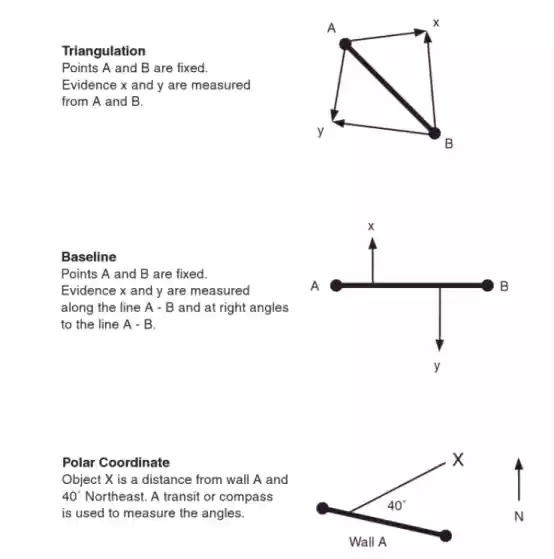
five types of crime search patterns?
zone, line/strip, grid, wheel/ray, spiral
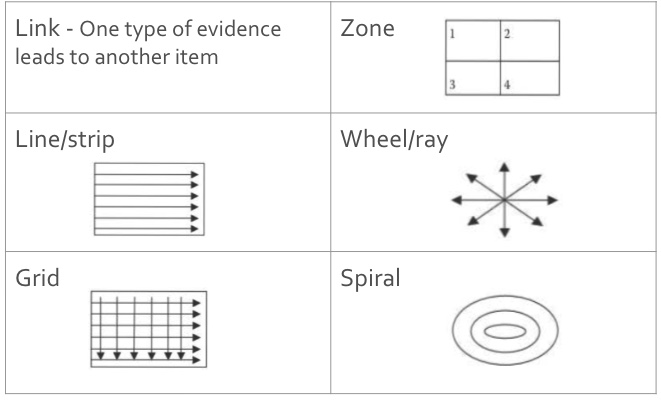
what is required during searching to improve visibility of bodily fluids/impression evidence?
enhancement reagents
the person who collects, marks, packages, seals and preserves evidence is known as what?
evidence collector
there is no order to the collection of evidence, but certain items should be given priority due to the severity
if evidence is moved/collected and more evidence is found, documentation must be done immediately
how is trace evidence packaged?
large pieces of paper are used for evidence that have trace evidence (ex. Pants with traces of hair), which are then put into outer containers
these are then sealed with tamper resistant tape, and also include other info such as the date, time and location
how is most evidence packaged?
in a primary container, that is put into a secondary container
what can be placed into airtight containers?
liquid and volatile items
biological evidence can be put in airtight containers, but it’s better to let them air dry in a controlled environment before doing so
the process of determining and eliminating events that could’ve occurred at the crime scene by analyzing the scene appearance, location and physical evidence is known as what?
crime scene reconstruction
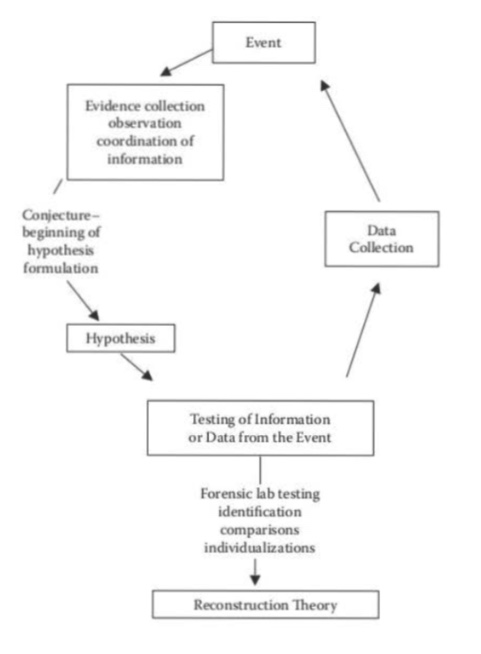
unexpected deaths/one thought to be caused by injury investigated to see if it was homicide are known as what?
death investigation
these are completed by a certified death investigator, and the methods vary throughout the world
difference between coroners and medical examiners/forensic pathologists?
difference is qualifications, medical examiners have degrees and specialized training, but coroners are not required to be doctors (they usually also have a background in law)
before, coroners worked judicially and determined the causes of deaths, but no prior training/education was required (this was changed in the late 19th century)
coroners are elected in
physicians that specialize in pathology (diagnosis of disease) who then subspecialize in law and medicine are known as what?
forensic pathologists
difference between cause and mechanism of death?
Cause of death is whatever caused the victim to die; the lethal chain of events
Mechanism of death the specific change in the body that causes the victim to die (ex. Extreme blood loss caused by a bullet, not receiving enough oxygen)
Injury has a higher priority over disease when it comes to determining the cause of death
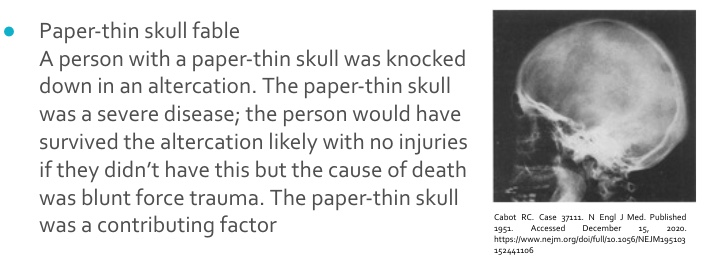
what is the manner of death?
The way the victim died
There are numerous possible causes of death, but only 5 manners of death:
Natural
Solely caused by disease, with no trauma interventions
Accidental
Trauma induced
Suicidal
Trauma induced
Homicidal
Trauma induced
Undetermined
what is livor mortis?
the body becomes discolored from red blood cells settling after it stops circulating, can be seen minutes after death, slowly disappears with decomposition after 36 hours
what is algor mortis?
the body cools until it matches the ambient temperature of the environment (can also become warmer if in a warm environment)
what is rigor mortis?
the muscles stiffen after ~4 hours; disappears after 24-36 hours
tools of death investigation?
reviewing the victim’s medical history (is it sudden/unexpected?)
reviewing witness statements, to help determine jurisdiction if injury is not obvious
this can potentially create prejudice of the forensic pathologist!
scene examination
Ideally, the forensic pathologist would come and look for themselves, but it is impractical due to costs
They are usually only sent to unusual or complicated scenes
a dissection of the human body to determine the cause of death is known as what?
an autopsy
Objections by relatives are also allowed, but autopsies are necessary if the death is within jurisdiction and there is no other way possible to determine the cause of death
brief process of an autopsy?
The organs are removed through incision of the chest, abdomen and head
Inframammary incision begins at each shoulder, extending to the midline of the body in the lower chest, and extended to the top of the pubic bone (T-shaped incision)
Examination of the brain – an incision is made from behind one ear to the other, the scalp is lifted upwards and backwards, then the skull is sawed in a circular cut, then the skull cap is removed
The organs are then weighed and dissected to determine the injury/disease
what are blood and urine used to determine?
the presence of drugs
what is formaldehyde used for?
used to preserve small portions of internal organs
what can traumatic deaths (natural, suicidal, homicidal, accidental) be classified as?
Mechanical
Sharp force
Blunt force
Non-firearm
Firearm
Thermal
Chemical
Electrical
Trauma is either classified as penetrating (gunshot, stab wound) or non-penetrating (vehicle collisions)
tissue damage from a mechanical force is known as what?
mechanical damage; happens when the physical force exceeds the tensile strength of the tissue
sharp force injury vs blunt force injury?
sharp force causes incisions (ex. knives, swords) while blunt force causes lacerations
sharp force causes penetration, while blunt force is damaged by impact
what are the two major mechanisms of death with mechanical trauma?
exsanguination; severe blood loss and severe brain damage
difference between penetrating and perforating gunshot wounds?
Penetrating gunshot wounds have an entrance wound but no exit, so they must be retrieved during autopsy
Perforating gunshot wounds have both an entrance and an exit wound
what happens when shots are fired?
the bullet is ejected, along with hot expanding gases, unburned propellant and other residue
these are important for determining the distance from which the gun was fired!

evidence of contact gunshot wounds?
Skin can show laceration due to gas blown into the wound that tears it apart, making the skin turn black
Carbon monoxide reacts with hemoglobin and myoglobin to form carboxyhemoglobin and carboxymyoglobin (bright red)
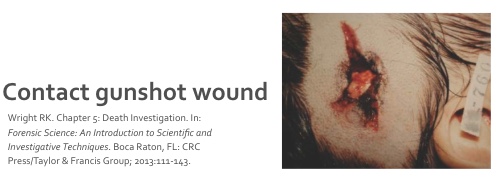
Effects of the gas diminish as the distance from the barrel to the skin increase, so only the bullet and unburned powder penetrate the skin, creating stippling/tattooing around the bullet hole
This is evidence of what type of bullet hole?
intermediate-range gunshot wounds
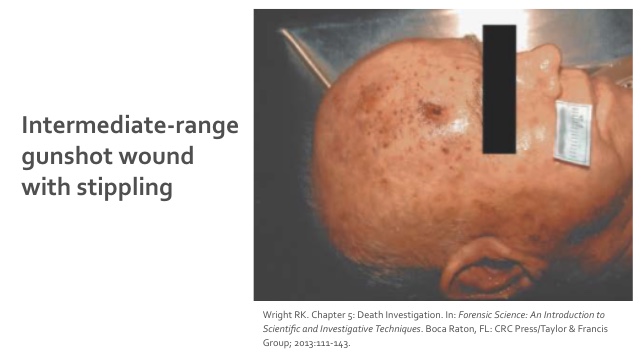
things to note when looking at distant gunshot wounds?
Distant gunshot wounds do not have the effects from gases/powder, so the range cannot be determined from these types
The typical wound has a circular skin defect with scraped skin around the edges
The diameter of the wound can be an indicator for the diameter of the bullet, but that’s not 100% reliable
what are the most common form of non-firearm blunt trauma injuries?
motor vehicle collisions
contusion vs hematoma?
Contusion, aka a bruise, is accumulated blood in the tissues outside of the blood vessels
Hematoma, or a blood tumor, is the same but with more blood, blood vessel damage, and more painful
death that result in the usage of drugs or poisons is known as what?
chemical trauma
mechanisms of death by central nervous system depressants + examples?
increasing degrees of a coma, followed by cessation of breathing and subsequent death
Alcohol
Barbiturates
Benzodiazepines
Opiates
mechanisms of death by central nervous system stimulants + an example?
seizures, exceedingly high body temperatures and uncontrolled quivering of the heart
Cocaine
what gas is common in suicidal, homicidal and accidental deaths?
carbon monoxide
what is thermal trauma?
being exposed to excessive heat (hyperthermia) or cold (hypothermia)
These cause death via a breakdown in the mechanisms that maintain body temperature around 37 degrees Celsius
what is usually the cause of deaths at scenes of fire?
usually from smoke inhalation instead of burns
what does low voltage passing through a person cause (electrical trauma)?
At low voltage, the heart can experience ventricular fibrillation (a form of cardiac arrest), an irregular heartbeat that can lead to non-resuscitability (the inability to restore a person to consciousness/responsiveness (ex. CPR)
what does high voltage passing through a person cause (electrical trauma)?
At a high voltage, the heart may experience defilibration (a dangerously chaotic heartbeat)
This leads to tetany, the involuntary contraction of muscles
the flow of electrical current through tissue, creating holes in the membrane is known as what?
poration
can cause loss of limbs
some causes of asphyxia?
Asphyxia happens when oxygen flow to the brain is interrupted by:
Manual strangulation
Strangulation by ligature (hanging)
Drowning
Thermal or chemical means